
How to Cite
Share
Abstract
In the last three field seasons the Geological Survey of Denmark and Greenland (GEUS) has undertaken mapping in the south-eastern part of the Nuuk region in southern West Greenland, and here we present new zircon ages that help constrain the northern boundary of the Tasiusarsuaq terrane. The Archaean geology of the Nuuk region is commonly interpreted as a tectonic collage assembled through lateral accretion and collision of oceanic and continental slivers and blocks (e.g. Friend & Nutman 2005). Popular jargon describes these as terranes, bounded by faults or mylonite zones and characterised by rocks of contrasting origin on either side of their tectonic boundaries (Coney et al. 1980). The Isukasia and Færingehavn terranes (Figs 1, 2) are the oldest terranes at ≥3.75 Ga, and extend from the outer part of Godthåbsfjord in the south-west to the margin of the Inland Ice in the north-east, but they might not have a common geological history (Friend & Nutman 2005). The Tre Brødre terrane is mainly represented by the Ikkatoq gneiss and occurs in close spatial relationship with the Færingehavn terrane, and also as a pronounced thrust unit along the Qarliit Nunaat thrust between the Færingehavn and Tasiusarsuaq terranes (Fig. 1; Nutman et al. 1989). The terrane boundaries in the inner fjord region near the Inland Ice margin are less well constrained; the Tre Brødre terrane extends into the region from the south-west, the Kapisilik terrane is defined from the northern and eastern part and borders the Tasiusarsuaq terrane to the south and possibly to the east. The terrane accretion is believed to have taken place in two events. The first terrane accretion is defined from the northern part of the region, and possibly involves the Isukasia, Kapisilik and Akia terranes. The thermal event stitching these terranes is dated to c. 2.99–2.95 Ga (Fig. 2; Hanmer et al. 2002; Friend & Nutman 2005). The second accretion phase of the major continental blocks is believed to have occurred at around 2.725–2.71 Ga. This second event is well described, and includes anatexis and emplacement of continental crust-derived granites, which are associated with contemporaneous metamorphism (Friend et al. 1996). Figure 2 outlines regional plutonic, metamorphic and supracrustal events. Individual terranes were formed during relatively short time periods with active geological processes of creation and recycling of continental crust, and most of the terranes follow a similar pattern of development. The first plutonic events consisted of primitive magmas and produced tonalite–trondhjemite–granodiorite (TTG) and dioritic gneisses. Younger, more evolved granitic magmas were often intruded simultaneously with high-grade metamorphism. This development may reflect a stabilisation of the individual terranes.
How to Cite
Share
Copyright (c) 2008 Tomas Næraa, Anders Scherstén

This work is licensed under a Creative Commons Attribution 4.0 International License.
Downloads
Edited by Ole Bennike and A.K. Higgins
This Review of Survey activities presents a selection of 22 papers reflecting the wide spectrum of activities of the Geological Survey of Denmark and Greenland, from the microscopic to the plate-tectonic level.
The Survey's activities in Denmark are illustrated by 13 articles. Five of them deal with petroleum-related [...]









